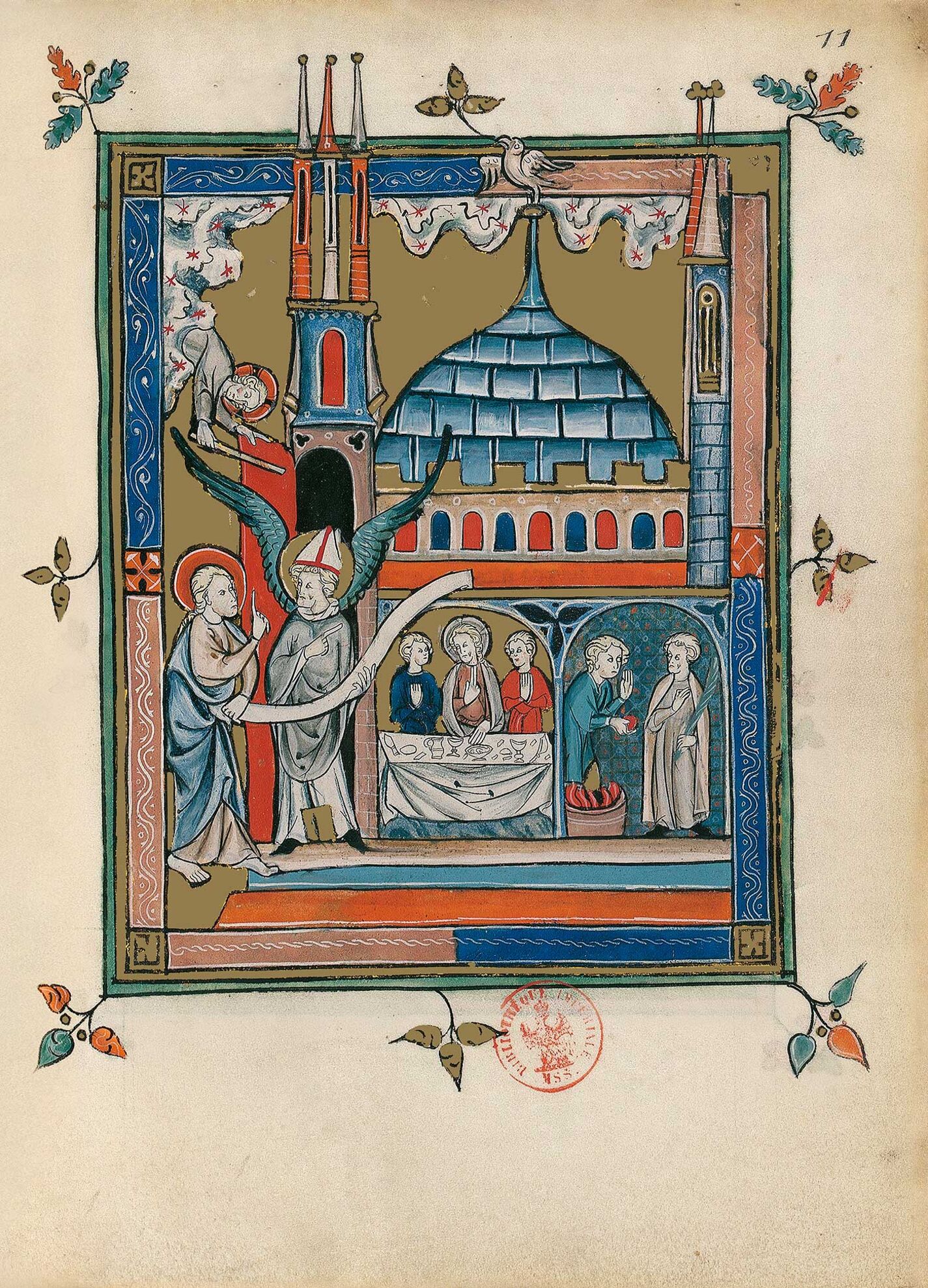The Church of Laodicea is built like the Church of Smyrna. It has an entrance tower and slender turrets around a wide open space beneath a dome whose summit is crowned by a point decorated not with a large finial but a white bird. The bishop angel stands in front of the building’s entrance with outstretched wings. He receives the phylactery symbolising God’s message and seems to listen attentively to the words conveyed by John, shown raising his index finger. This gesture of admonition is in line with the reproachful tone of the text, “I know your deeds, you are neither hot nor cold” which is transformed into fatherly scolding. “Those I do love, I reprimand and punish”, writes the apostle inspired by the wisdom of the book of Proverbs, “For whom the Lord loveth, he chastiseth: and as a father in the son he pleaseth himself” (Prov. 3: 12). The illustration follows this line of hope by portraying the willingness of the community of Laodicea to conform to the teachings they are reminded about. Depicted beneath the church’s huge dome are no orgies or idolatry but two scenes announcing conversion and the ensuing reward. The space is divided into two arcatures. Depicted beneath the one on the right is a man already dressed in the white coat and tunic symbolising the baptismal innocence regained. He carries a palm and listens to the merchant holding a small pot of ointment out to him, probably the eye lotion essential for recovering one’s sight and a colourful way of depicting the action of the Holy Ghost that enables a lucid view of oneself. During this exchange, the gold to be obtained by the faithful is being “purified by fire” and a fragment of it can be seen amongst the coals in the hearth. According to the commentator, this gold is either wisdom or charity “inflamed by the ardour of God’s pure love stripped of any worldly trace”. Beneath the left-hand arcature, the promise of communion with God is fulfilled: Christ sits at the table of those who have heard his call. Descending from heaven, he strikes the leaf of the door with a rod before participating in the dinner. According to an iconographic model based on the encounter with the disciples on the road to Emmaus, two men stand in thought before the set table being blessed by the Saviour. This proximity, conveyed by the conviviality during the meal, is one of the main images used in the Bible to evoke eternal bliss.
Marie-Thérèse Gousset and Marianne Besseyre
Illuminated Manuscripts Research Center, Bibliothèque nationale de France
Fragment of the Apocalypse of 1313 commentary volume

The Church of Laodicea is built like the Church of Smyrna. It has an entrance tower and slender turrets around a wide open space beneath a dome whose summit is crowned by a point decorated not with a large finial but a white bird. The bishop angel stands in front of the building’s entrance with outstretched wings. He receives the phylactery symbolising God’s message and seems to listen attentively to the words conveyed by John, shown raising his index finger. This gesture of admonition is in line with the reproachful tone of the text, “I know your deeds, you are neither hot nor cold” which is transformed into fatherly scolding. “Those I do love, I reprimand and punish”, writes the apostle inspired by the wisdom of the book of Proverbs, “For whom the Lord loveth, he chastiseth: and as a father in the son he pleaseth himself” (Prov. 3: 12). The illustration follows this line of hope by portraying the willingness of the community of Laodicea to conform to the teachings they are reminded about. Depicted beneath the church’s huge dome are no orgies or idolatry but two scenes announcing conversion and the ensuing reward. The space is divided into two arcatures. Depicted beneath the one on the right is a man already dressed in the white coat and tunic symbolising the baptismal innocence regained. He carries a palm and listens to the merchant holding a small pot of ointment out to him, probably the eye lotion essential for recovering one’s sight and a colourful way of depicting the action of the Holy Ghost that enables a lucid view of oneself. During this exchange, the gold to be obtained by the faithful is being “purified by fire” and a fragment of it can be seen amongst the coals in the hearth. According to the commentator, this gold is either wisdom or charity “inflamed by the ardour of God’s pure love stripped of any worldly trace”. Beneath the left-hand arcature, the promise of communion with God is fulfilled: Christ sits at the table of those who have heard his call. Descending from heaven, he strikes the leaf of the door with a rod before participating in the dinner. According to an iconographic model based on the encounter with the disciples on the road to Emmaus, two men stand in thought before the set table being blessed by the Saviour. This proximity, conveyed by the conviviality during the meal, is one of the main images used in the Bible to evoke eternal bliss.
Marie-Thérèse Gousset and Marianne Besseyre
Illuminated Manuscripts Research Center, Bibliothèque nationale de France
Fragment of the Apocalypse of 1313 commentary volume